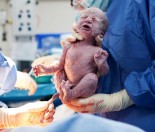This easy to use pregnancy and birth terms glossary helps you understand terms commonly used by midwives, doctors and those in the know!
Once you’ve found the pregnancy term you’re looking for, make sure to scroll to the end of this page for links to our most popular pregnancy advice articles.
Amniotic fluid
At the end of pregnancy the baby is surrounded by approximately 1 litre of fluid, which is swallowed by the baby, and also allows the baby to freely move around. Also known as ‘the waters’.
Anaemia
When you have a reduced number of red blood cells / haemoglobin, which carries oxygen in your blood. It can make you very tired and weak.
Antenatal
Before birth
Antepartum Haemorrhage
Bleeding from the vagina after 28 weeks of pregnancy – can be caused by placenta praevia, placental abruption or minor causes such as post sexual intercourse. All bleeding in pregnancy should be reported to a health professional.
ARM
Artificial Rupture of Membranes – breaking the waters using a plastic hook, usually to speed up labour.
Braxton Hicks contractions
Contractions of the womb during pregnancy, which are usually painless and are perfectly normal “practice” contractions.
CTG
Cardiotocograph is a method of continuously monitoring your contractions and the baby’s well-being in labour. Two monitors are strapped to the woman’s abdomen, recording both the heart beat of the baby and the woman’s contractions on a graph. (The heart beat can also be picked up using a fetal scalp electrode).
Cervix
The neck of the womb, which opens into the vagina and dilates in labour, allowing space for the baby to pass through the birth canal.
Colostrum
A yellow milky fluid produced in the breasts during pregnancy and for 3-4 days after the birth. It is high in antibodies.
Contractions
A temporary shortening of the fibres in the muscle of the womb, which causes the cervix to open in labour
Dilatation
The cervix needs to open to allow the baby to pass through into the vagina. This is known as dilatation. A fully dilated cervix has opened approximately 10cm.
EDD
Estimated Date of Delivery – the baby usually comes in the time period 2 weeks before or after this date
Effacement
This is the thinning of the cervix which takes place in early labour for first time mums. For subsequent births it occurs as the cervix opens.
Embryo
The term given to your baby for the first 8 weeks following conception (after which it is called a fetus).
Entonox
50% oxygen / 50% nitrous oxide (laughing gas) combined to form a gas that you can breath during contractions, to provide some pain relief. Also known as ‘gas and air’.
Epidural
A form of pain relief for labour: local anaesthetic drugs and opiate analgesic drugs are injected into the epidural space in the spine, in order to block the spinal nerves and relieve pain.
Episiotomy
An incision / cut made into the perineum to widen the vaginal opening for childbirth, done using local anaesthetic.
Ergometrine
A drug used to prevent/ control excessive bleeding during the third stage of labour. It causes a contraction of the muscles of the womb.
Established labour
Regular, painful contractions that are opening the cervix.
Fetal blood sampling
A tiny sample of blood is taken from baby’s scalp during a vaginal examination in labour, to check the baby’s blood gas levels, to see if the baby is getting enough oxygen.
Fetal distress / hypoxia
The baby has a reduced oxygen supply while it is in the womb. This will affect the baby’s heart beat.
Fetal monitoring
The baby’s well-being is monitored during labour by checking the heart beat, observing the colour of the waters and occasionally by fetal blood sampling
Fetal Scalp Electrode
A metal clip (electrode) is attached to baby’s scalp in labour, during a vaginal examination. This is attached to a CTG machine to closely monitor baby’s heart rate.
Fetus
The term used for a baby from 8 weeks after conception until the birth.
First stage of labour
The onset of labour until the cervix is fully dilated
Forceps
Surgical instruments used occasionally by doctors to help deliver the baby’s head.
Haemorrhoids
Varicose (swollen) veins in the lower rectum and anus (back passage). Also known as ‘piles’.
HCG
Human Chorionic Gonadotrophin – a hormone of pregnancy which sends a message for the body to keep producing oestrogen and progesterone, to maintain the pregnancy.
Induction of labour
Artificially starting labour – using prostaglandins, artificial rupture of membranes and syntocinon.
Intervention
A procedure which is not part of the natural process of labour and birth – eg. artificially rupturing the membranes.
Labour
Contractions of the muscle of the womb, which lead to the opening of the cervix, followed by the birth of the baby and the expulsion of the afterbirth. These make up the 3 stages of labour.
Local anaesthetic drugs
Drugs which are given to a part of the body to prevent pain, or sensation – eg. as part of an epidural, or in the vaginal area.
LMC
Lead Maternity Carer – in New Zealand every woman is entitled to a midwife or doctor who will be responsible for her care.
LMP
Last Menstrual Period – the first day of your last period is used to calculate your estimated date of delivery
Opiate analgesic drugs
These are powerful pain relieving drugs, such as morphine and pethidine.
Meconium
This is baby’s first bowel motion – it is the mucus, cells and bile pigment that have been in the intestines during pregnancy. It is green/ black and ‘sticky’. As milk is taken the colour changes to green then yellow – the normal colour for ‘baby poo’.
Membranes
The baby is surrounded by 2 membranes, which are called the amnion and chorion. In effect it is as though the baby is in a balloon filled with water.
Menstrual period
At the end of each menstrual cycle of approximately 28 days women have a vaginal discharge of blood, which lasts 2-6 days, as the lining of the womb prepares for the next cycle.
Multigravida
A pregnant woman who has had more than one pregnancy
Normal birth
The baby is born solely by maternal effort.
Operculum
A mucus plug which fills the cervix in pregnancy and protects the baby from infection from the vagina. When it is passed in labour it is called ‘a show’.
Oxytocin
A hormone which stimulates the muscles of the womb to contract in labour and the milk to be released during breastfeeding. Women produce this naturally and it can also be given as a drug (syntocinon).
Perineum
A pyramid of muscles between the lower vagina and the back passage, covered with skin.
Pethidine
A pain relieving drug, given by injection in labour. Can be given into the muscle or directly into the vein.
Placenta
This is the organ which is formed in early pregnancy to feed and nourish the baby and remove waste products. It looks like liver and it weighs 1/6 of baby’s weight. Also known as the “afterbirth”.
Placental Abruption
Separation of the placenta from the wall of the womb after 28 weeks of pregnancy. This is rare, but can cause heavy bleeding and is a risk to mum and baby.
Placenta Praevia
The placenta is situated low in the womb and can be covering the cervical opening, making vaginal birth of the baby impossible. There is a risk of bleeding if labour starts before a planned caesarean section is performed.
Postnatal
After childbirth – usually referring to the first 6 weeks after the birth.
Post Partum Haemorrhage
Abnormal blood loss after the birth of a baby.
Pregnancy
The time period when a baby is developing inside your body – the usual length of pregnancy from conception to birth is approximately 265 days.
Primigravida
A woman pregnant for the first time.
Progesterone
A hormone of pregnancy, also a vital part of the menstrual cycle.
Prostaglandins
Hormones which ripen / soften the cervix to prepare for labour (present in semen). These are present in ‘prostin’ pessaries (tablets inserted into vagina, next to cervix), which are used to induce labour.
Second stage of labour
The stage of labour from full dilatation of the cervix to the birth of the baby.
Show
See operculum
SRM
Spontaneous Rupture of Membranes – the waters break naturally, usually during a contraction. (In 10% of women this happens prior to labour.)
Syntocinon
A synthetic form of the hormone oxytocin, which stimulates muscle contractions in the womb. It can be given in tiny amounts to induce / speed up labour via a drip. It is also given to prevent or treat excessive bleeding during the third stage of labour.
Sytometrine
An injection that is given in mum’s leg as the baby is born, causing a contraction of the womb and separation of the placenta. It contains syntocinon and ergometrine (see above).
Third stage of labour
The stage of labour from the birth of the baby to the delivery of the placenta and membranes. It can be physiological (ie. natural, with no drugs) or active (drugs given to mum to cause the womb to contract).
Trimester
A period of 3 months. Pregnancy is divided into 3 trimesters, being a total of 9 months.
Umbilical cord
The cord which links mum and the baby in the womb. Three blood vessels are protected by a jelly-like substance – they carry nutrients to baby and waste products back to mum. It is usually 50-60cm long.
USS
Ultra Sound Scan – a diagnostic scan where the reflections of ultrasonic waves are directed onto tissues and displayed as a television image. This is used widely in pregnancy, to detect abnormalities in babies and to measure the size of babies in the womb.
Uterus
A pear shaped, hollow organ which grows from 60 grams to 900 grams in pregnancy to provide protection and nutrition for the growing baby inside. Also known as the womb.
Varicose veins
Swollen veins, common in pregnancy due to the hormonal changes of progesterone, which softens all plain muscle in the body. Varicose veins may develop in the legs, vulva and the back passage (see haemorrhoids).
Ventouse
Used to help deliver baby in the second stage of labour, as an alternative to forceps. A metal or silicone cup is placed over baby’s head by the doctor who uses gentle traction, combined with mum’s effort, to deliver the baby.
Womb
See uterus
For advice on nutrition, check out Good nutrition choices in pregnancy. For information on eating and exercise prior to becoming pregnant, check out Pregnancy preconception care. And for a great list of services to help once your baby arrives, check out 51 New Zealand services for new parents.







I am having back pain,belly pains,and I eat but I feel like I didnt eat at all very tired and my legs hurt ti and keep spoting off and on
this is soooooo scary i don’t want to get pregnant ever!!! 🙁
Hahah it’s not so bad, really 🙂